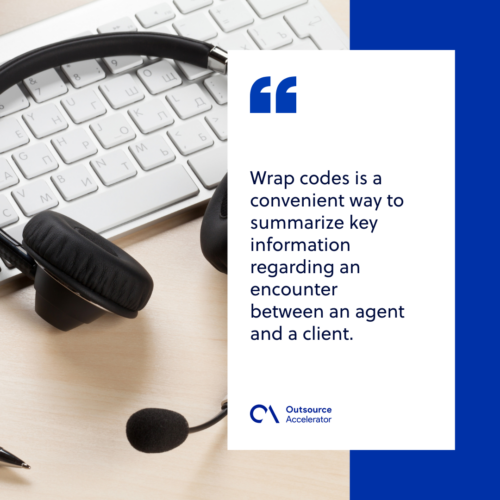Call center wrap codes
Definition
What are call center wrap codes?
Wrap codes are intended to record the most general information. It is a convenient way to summarize key information regarding an encounter between an agent and a client. Wrap codes are also known as disposition codes or call codes.
It will include data such as why the contact was made, what the outcome was, and whether any additional action is necessary. Wrap codes are usually selected from a drop-down list of alternatives.
Following a call, most automatic call distributions will put the agent in a not-ready status, preventing new calls from being routed to them while they finish up after-call work (ACW).
During wrap time, one of the most important pieces of ACW that the agent must perform is entering wrap codes.
In addition, if the agent wants to record more specific information about a call, he or she will be able to attach notes to the client file. Call center wrap codes, on the other hand, are solely meant to record the broadest and generic information.
Some call types are more difficult to identify, and there may not be a clear wrap code to record them with. Regular audits can be beneficial in detecting call types that do not have an associated code.
Further, this can help determine if wrap codes should be eliminated because of process changes. The amount of alternatives an agent must look through is reduced by removing unnecessary codes.
Since call center wrap codes are important for planning, some centers use code corrections as a key performance indicator for individual agents. When assessing sample calls, it’s a good idea to verify call center wrap codes and inform agents they’ll be used as part of the scoring criteria.

What is the maximum number of wrap codes?
Your call center telephony platform sets the physical limit, but that’s the least priority. The more you have, the less likely they are to be used correctly by frontline agents.
It is possible to create a hierarchy of codes, which makes it easier for the agent to choose from rather than an extensive list. The more alternatives you provide, the more probable it is that agents will misuse them.
What do call center wrap codes do?
They provide each call with an identification that allows you to count how many times each code has been called.
As a result, a call center manager or business may use them to determine the number of calls received for various issues. They may also use that knowledge to enhance the call center and the business.
What are the limitations of wrap codes?
Since call center wrap codes are manually applied, they aren’t always the most accurate source of data and they are so simple to deploy. Data management may want to measure various subjects, resulting in an excess of codes for agents to correctly enter.
Another issue in call centers is employing them for no apparent reason. No one looks at them. Frontline agents have never provided feedback on their use, and the accuracy of the input is never checked as part of any quality assurance or compliance program.







 Independent
Independent




